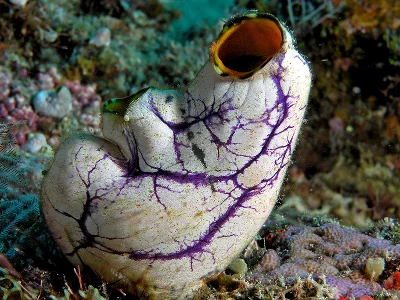Tunicata
A tunicate is a marine invertebrate animal belonging to the subphylum Tunicata. These organisms are part of the Chordata, a phylum that includes animals with dorsal nerve cords and notochords, including vertebrates. Previously known as Urochordata, they are sometimes still referred to as urochordates. Tunicates are the only chordates that have lost their myomeric segmentation, although some display segmentation of the muscle bands, such as doliolids.
Tunicates can exist as solitary individuals or form colonies through budding, with each unit called a zooid. They are filter feeders, residing in marine habitats, and have a sac-like body structure filled with water. The organism possesses two tubular openings known as siphons, through which it draws in and expels water. Water is taken in through the incurrent siphon during respiration and feeding, while filtered water is expelled through the excurrent siphon. Adult ascidian tunicates are sessile, permanently attached to rocks or other hard surfaces on the ocean floor. Thaliaceans, including pyrosomes, doliolids, and salps, as well as larvaceans, swim in the pelagic zone of the sea in their adult stage.
A well-known class of tunicates is ascidians, often referred to as sea squirts, sea pork, sea livers, or sea tulips. These organisms have various species within their class. The earliest probable species of tunicate can be traced back to the early Cambrian period. Despite their simple appearance and distinct adult form, their close relationship to vertebrates is evident during their mobile larval stage, where they possess a notochord or stiffening rod and resemble tadpoles. The name "tunicate" derives from their unique outer covering or "tunic," which is composed of proteins and carbohydrates and acts as an exoskeleton. The thickness and texture of the tunic can vary among species, ranging from thin, translucent, and gelatinous to thick, tough, and rigid.



